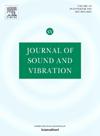Optimal trajectory planning of space flexible-link manipulator based on singular perturbation theory
IF 4.3
2区 工程技术
Q1 ACOUSTICS
引用次数: 0
Abstract
In this paper, a computationally efficient joint trajectory planning method for a space flexible-link manipulator is proposed based on the Singular Perturbation (SP) theory. The dynamic coupling of the space flexible-link manipulator is decomposed into the coupling between the rigid motions of the base and link, and the coupling between the rigid motion and the flexible vibration according to the SP theory. The dynamic coupling between the base and the link is used to adjust the position and attitude of the base and the link vibration is reduced based on the coupling between the rigid motion and flexible vibration. According to SP theory, the rigid motion of the base is approximated by its quasi-steady state value. A low frequency vibration around quasi-steady state value of link vibration is obtained and used to approximate the dynamic behavior of link vibration within fast time scale. On this basis, two novel objective functions of minimizing vibration during motion and residual vibration are constructed. Since the calculation of high-frequency vibration is avoided, the efficiency of the trajectory optimization method is greatly improved. Particle Swarm Optimization (PSO) algorithm is adopted to realize multi-objective optimization. Numerical simulations are performed to verify the vibration reduction effect and ability of achieving multi-objective optimization of the proposed method. Moreover, experiments are conducted to further validate the vibration reduction effect of the proposed method.
基于奇异摄动理论的空间柔性连杆机械臂最优轨迹规划
基于奇异摄动理论,提出了一种计算效率高的空间柔性连杆机械臂关节轨迹规划方法。根据SP理论,将空间柔性连杆机械臂的动力学耦合分解为基座与连杆的刚性运动耦合和刚性运动与柔性振动的耦合。利用基座和连杆之间的动态耦合来调节基座的位置和姿态,并利用刚性运动和柔性振动之间的耦合来减小连杆的振动。根据SP理论,基座的刚体运动近似于它的准稳态值。得到了连杆振动准稳态值附近的一个低频振动,用于近似快速时间尺度内连杆振动的动态特性。在此基础上,构造了运动过程振动最小和残余振动最小两个新的目标函数。由于避免了高频振动的计算,大大提高了轨迹优化方法的效率。采用粒子群优化算法(PSO)实现多目标优化。通过数值仿真验证了该方法的减振效果和实现多目标优化的能力。通过实验进一步验证了该方法的减振效果。
本文章由计算机程序翻译,如有差异,请以英文原文为准。
求助全文
约1分钟内获得全文
求助全文
来源期刊

Journal of Sound and Vibration
工程技术-工程:机械
CiteScore
9.10
自引率
10.60%
发文量
551
审稿时长
69 days
期刊介绍:
The Journal of Sound and Vibration (JSV) is an independent journal devoted to the prompt publication of original papers, both theoretical and experimental, that provide new information on any aspect of sound or vibration. There is an emphasis on fundamental work that has potential for practical application.
JSV was founded and operates on the premise that the subject of sound and vibration requires a journal that publishes papers of a high technical standard across the various subdisciplines, thus facilitating awareness of techniques and discoveries in one area that may be applicable in others.
 求助内容:
求助内容: 应助结果提醒方式:
应助结果提醒方式:


